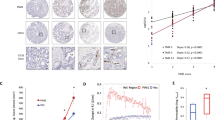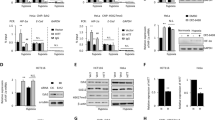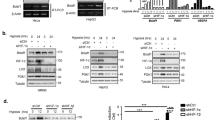Abstract
Hypoxia-inducible factor-1α (HIF1α) is a crucial regulator of the cellular response to hypoxia through its regulation of genes that control erythropoiesis, angiogenesis and anaerobic metabolism. We have previously shown that HIF1α stability is regulated by SUMOylation under the hypoxic condition. However, how HIF1α became SUMOylated during hypoxia is still unknown. In this study we identify PIASy as a specific E3 ligase for hypoxia-induced HIF1α SUMOylation. Hypoxia promotes translocation of HIF1α to the nucleus to facilitate its binding to PIASy, enabling the conjugation of HIF1α by SUMO1. We further show that PIASy negatively regulates hypoxia-induced HIF1α stability and transactivation. Knocking down PIASy increases the angiogenic activity of endothelial cells. Moreover, we show an inverse relationship between expression of PIASy and tumor angiogenesis in colon cancer. Thus, we define an important role of PIASy in hypoxia signaling through promoting HIF1α SUMOylation.
This is a preview of subscription content, access via your institution
Access options
Subscribe to this journal
Receive 50 print issues and online access
$259.00 per year
only $5.18 per issue
Buy this article
- Purchase on Springer Link
- Instant access to full article PDF
Prices may be subject to local taxes which are calculated during checkout





Similar content being viewed by others
References
Bae SH, Jeong JW, Park JA, Kim SH, Bae MK, Choi SJ et al. (2004). Sumoylation increases HIF-1alpha stability and its transcriptional activity. Biochem Biophys Res Commun 324: 394–400.
Berta MA, Mazure N, Hattab M, Pouyssegur J, Brahimi-Horn MC . (2007). SUMOylation of hypoxia-inducible factor-1alpha reduces its transcriptional activity. Biochem Biophys Res Commun 360: 646–652.
Brahimi-Horn C, Mazure N, Pouyssegur J . (2005). Signalling via the hypoxia-inducible factor-1alpha requires multiple posttranslational modifications. Cell Signal 17: 1–9.
Branzei D, Sollier J, Liberi G, Zhao X, Maeda D, Seki M et al. (2006). Ubc9- and mms21-mediated sumoylation counteracts recombinogenic events at damaged replication forks. Cell 127: 509–522.
Bruick RK, McKnight SL . (2001). A conserved family of prolyl-4-hydroxylases that modify HIF. Science 294: 1337–1340.
Carbia-Nagashima A, Gerez J, Perez-Castro C, Paez-Pereda M, Silberstein S, Stalla GK et al. (2007). RSUME, a small RWD-containing protein, enhances SUMO conjugation and stabilizes HIF-1alpha during hypoxia. Cell 131: 309–323.
Carmeliet P, Dor Y, Herbert JM, Fukumura D, Brusselmans K, Dewerchin M et al. (1998). Role of HIF-1alpha in hypoxia-mediated apoptosis, cell proliferation and tumour angiogenesis. Nature 394: 485–490.
Carter S, Bischof O, Dejean A, Vousden KH . (2007). C-terminal modifications regulate MDM2 dissociation and nuclear export of p53. Nat Cell Biol 9: 428–435.
Cheng J, Kang X, Zhang S, Yeh ET . (2007). SUMO-specific protease 1 is essential for stabilization of HIF1alpha during hypoxia. Cell 131: 584–595.
Comerford KM, Leonard MO, Karhausen J, Carey R, Colgan SP, Taylor CT . (2003). Small ubiquitin-related modifier-1 modification mediates resolution of CREB-dependent responses to hypoxia. Proc Natl Acad Sci USA 100: 986–991.
Dawlaty MM, Malureanu L, Jeganathan KB, Kao E, Sustmann C, Tahk S et al. (2008). Resolution of sister centromeres requires RanBP2-mediated SUMOylation of topoisomerase IIalpha. Cell 133: 103–115.
Geiss-Friedlander R, Melchior F . (2007). Concepts in sumoylation: a decade on. Nat Rev Mol Cell Biol 8: 947–956.
Gong L, Kamitani T, Fujise K, Caskey LS, Yeh ET . (1997). Preferential interaction of sentrin with a ubiquitin-conjugating enzyme, Ubc9. J Biol Chem 272: 28198–28201.
Gruber M, Simon MC . (2006). Hypoxia-inducible factors, hypoxia, and tumor angiogenesis. Curr Opin Hematol 13: 169–174.
Hari KL, Cook KR, Karpen GH . (2001). The Drosophila Su(var)2-10 locus regulates chromosome structure and function and encodes a member of the PIAS protein family. Genes Dev 15: 1334–1348.
Hay RT . (2005). SUMO: a history of modification. Mol Cell 18: 1–12.
Hochstrasser M . (2001). SP-RING for SUMO: new functions bloom for a ubiquitin-like protein. Cell 107: 5–8.
Ivan M, Kondo K, Yang H, Kim W, Valiando J, Ohh M et al. (2001). HIFalpha targeted for VHL-mediated destruction by proline hydroxylation: implications for O2 sensing. Science 292: 464–468.
Jaakkola P, Mole DR, Tian YM, Wilson MI, Gielbert J, Gaskell SJ et al. (2001). Targeting of HIF-alpha to the von Hippel–Lindau ubiquitylation complex by O2-regulated prolyl hydroxylation. Science 292: 468–472.
Jackson PK . (2001). A new RING for SUMO: wrestling transcriptional responses into nuclear bodies with PIAS family E3 SUMO ligases. Genes Dev 15: 3053–3058.
Johnson ES, Gupta AA . (2001). An E3-like factor that promotes SUMO conjugation to the yeast septins. Cell 106: 735–744.
Kagey MH, Melhuish TA, Wotton D . (2003). The polycomb protein Pc2 is a SUMO E3. Cell 113: 127–137.
Kahyo T, Nishida T, Yasuda H . (2001). Involvement of PIAS1 in the sumoylation of tumor suppressor p53. Mol Cell 8: 713–718.
Kallio PJ, Okamoto K, O'Brien S, Carrero P, Makino Y, Tanaka H et al. (1998). Signal transduction in hypoxic cells: inducible nuclear translocation and recruitment of the CBP/p300 coactivator by the hypoxia-inducible factor-1alpha. EMBO J 17: 6573–6586.
Lando D, Peet DJ, Gorman JJ, Whelan DA, Whitelaw ML, Bruick RK . (2002). FIH-1 is an asparaginyl hydroxylase enzyme that regulates the transcriptional activity of hypoxia-inducible factor. Genes Dev 16: 1466–1471.
Mabb AM, Wuerzberger-Davis SM, Miyamoto S . (2006). PIASy mediates NEMO sumoylation and NF-kappaB activation in response to genotoxic stress. Nat Cell Biol 8: 986–993.
Matsuura T, Shimono Y, Kawai K, Murakami H, Urano T, Niwa Y et al. (2005). PIAS proteins are involved in the SUMO-1 modification, intracellular translocation and transcriptional repressive activity of RET finger protein. Exp Cell Res 308: 65–77.
Maxwell PH, Wiesener MS, Chang GW, Clifford SC, Vaux EC, Cockman ME et al. (1999). The tumour suppressor protein VHL targets hypoxia-inducible factors for oxygen-dependent proteolysis. Nature 399: 271–275.
Ohh M, Park CW, Ivan M, Hoffman MA, Kim TY, Huang LE et al. (2000). Ubiquitination of hypoxia-inducible factor requires direct binding to the beta-domain of the von Hippel–Lindau protein. Nat Cell Biol 2: 423–427.
Pouyssegur J, Dayan F, Mazure NM . (2006). Hypoxia signalling in cancer and approaches to enforce tumour regression. Nature 441: 437–443.
Rogers RS, Horvath CM, Matunis MJ . (2003). SUMO modification of STAT1 and its role in PIAS-mediated inhibition of gene activation. J Biol Chem 278: 30091–30097.
Sachdev S, Bruhn L, Sieber H, Pichler A, Melchior F, Grosschedl R . (2001). PIASy, a nuclear matrix-associated SUMO E3 ligase, represses LEF1 activity by sequestration into nuclear bodies. Genes Dev 15: 3088–3103.
Saitoh H, Sparrow DB, Shiomi T, Pu RT, Nishimoto T, Mohun TJ et al. (1998). Ubc9p and the conjugation of SUMO-1 to RanGAP1 and RanBP2. Curr Biol 8: 121–124.
Sapetschnig A, Rischitor G, Braun H, Doll A, Schergaut M, Melchior F et al. (2002). Transcription factor Sp3 is silenced through SUMO modification by PIAS1. EMBO J 21: 5206–5215.
Schmidt D, Muller S . (2002). Members of the PIAS family act as SUMO ligases for c-Jun and p53 and repress p53 activity. Proc Natl Acad Sci USA 99: 2872–2877.
Schofield CJ, Ratcliffe PJ . (2004). Oxygen sensing by HIF hydroxylases. Nat Rev Mol Cell Biol 5: 343–354.
Schwarz SE, Matuschewski K, Liakopoulos D, Scheffner M, Jentsch S . (1998). The ubiquitin-like proteins SMT3 and SUMO-1 are conjugated by the UBC9 E2 enzyme. Proc Natl Acad Sci USA 95: 560–564.
Shao R, Zhang FP, Tian F, Anders Friberg P, Wang X, Sjoland H et al. (2004). Increase of SUMO-1 expression in response to hypoxia: direct interaction with HIF-1alpha in adult mouse brain and heart in vivo. FEBS Lett 569: 293–300.
Shuai K, Liu B . (2005). Regulation of gene-activation pathways by PIAS proteins in the immune system. Nat Rev Immunol 5: 593–605.
Stebbins CE, Kaelin Jr WG, Pavletich NP . (1999). Structure of the VHL–ElonginC–ElonginB complex: implications for VHL tumor suppressor function. Science 284: 455–461.
Takahashi Y, Kahyo T, Toh EA, Yasuda H, Kikuchi Y . (2001). Yeast Ull1/Siz1 is a novel SUMO1/Smt3 ligase for septin components and functions as an adaptor between conjugating enzyme and substrates. J Biol Chem 276: 48973–48977.
van Hagen M, Overmeer RM, Abolvardi SS, Vertegaal AC . (2010). RNF4 and VHL regulate the proteasomal degradation of SUMO-conjugated hypoxia-inducible factor-2alpha. Nucleic Acids Res 38: 1922–1931.
Wang GL, Jiang BH, Rue EA, Semenza GL . (1995). Hypoxia-inducible factor 1 is a basic-helix-loop-helix-PAS heterodimer regulated by cellular O2 tension. Proc Natl Acad Sci USA 92: 5510–5514.
Yeh ET . (2009). SUMOylation and De-SUMOylation: wrestling with life's processes. J Biol Chem 284: 8223–8227.
Acknowledgements
This work was supported in part by National Natural Science Foundation of China (30772462, to JC; 30800579 to XK), National Key Scientific Program in China (2009CB918403, to JC), State Key Laboratory of Oncogenes and Related Genes (91-08-06, to JC), E-Institutes of Shanghai Municipal Education Commission (E09013, to JC) and NIH grants (CA239520, to ETHY). ETHY is the McNair Scholar of the Texas Heart Institute, St Luke Episcopal Hospital.
Author information
Authors and Affiliations
Corresponding author
Ethics declarations
Competing interests
The authors declare no conflict of interest.
Additional information
Supplementary Information accompanies the paper on the Oncogene website
Supplementary information
Rights and permissions
About this article
Cite this article
Kang, X., Li, J., Zou, Y. et al. PIASy stimulates HIF1α SUMOylation and negatively regulates HIF1α activity in response to hypoxia. Oncogene 29, 5568–5578 (2010). https://doi.org/10.1038/onc.2010.297
Received:
Revised:
Accepted:
Published:
Issue Date:
DOI: https://doi.org/10.1038/onc.2010.297
Keywords
This article is cited by
-
The emerging roles of SUMOylation in the tumor microenvironment and therapeutic implications
Experimental Hematology & Oncology (2023)
-
Role of non-canonical post-translational modifications in gastrointestinal tumors
Cancer Cell International (2023)
-
β-arrestin 2 stimulates degradation of HIF-1α and modulates tumor progression of glioblastoma
Cell Death & Differentiation (2021)
-
Protein Modifications with Ubiquitin as Response to Cerebral Ischemia-Reperfusion Injury
Translational Stroke Research (2018)
-
Topotecan is a potent inhibitor of SUMOylation in glioblastoma multiforme and alters both cellular replication and metabolic programming
Scientific Reports (2017)



